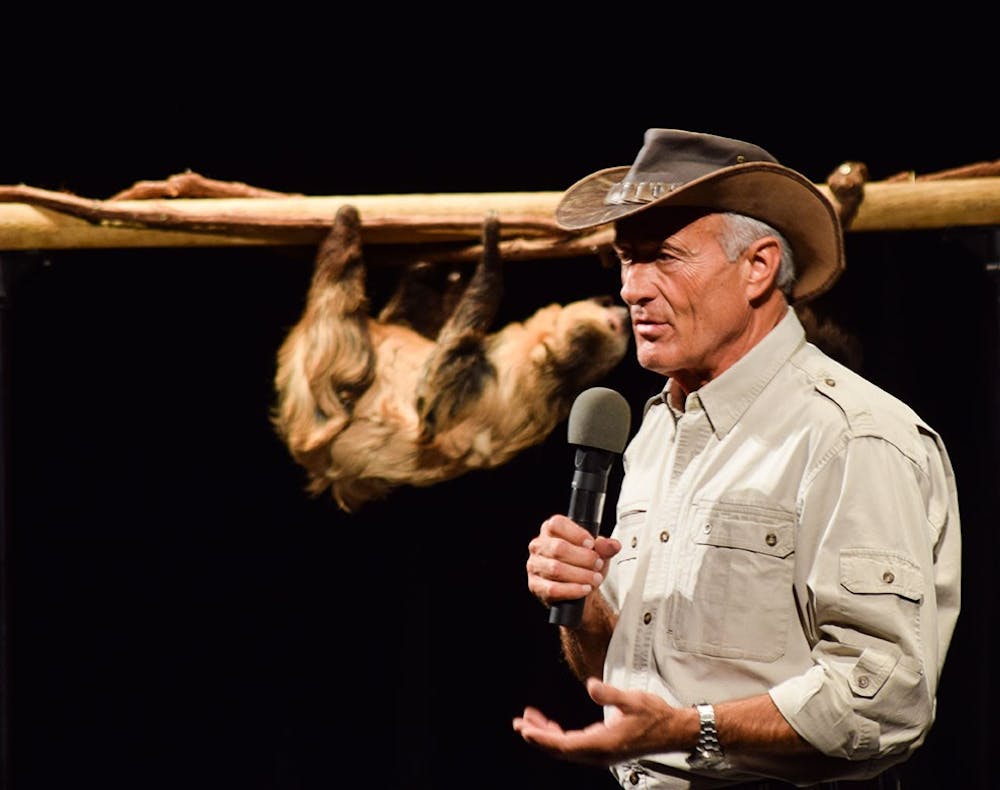Children and adults explored the wild world of animals with “Jungle” Jack Hanna last Friday at the H. Ric Luhrs Performing Arts Center.
Kids talked and laughed excitedly in their seats before the performance. Some imitated their favorite animal to their parents while others wondered aloud which animals they would see that night. Many quizzed themselves with animal trivia questions that were projected onto the large video screen.
Finally, the lights dimmed and a video began the performance. African music played while scenes of wild animals lit up the screen. Children bounced in their seats, awed at the dolphins, giraffes, rhinos and other animals that appeared.
As the video ended, a round of applause greeted Hanna as he came onstage.
Famous for his show “Jack Hanna’s Animal Adventures,” Hanna has appeared on shows such as “The Late Show with David Letterman” and “Good Morning America.”
Known as the face of zoo keeping and animal education, Hanna has brought wildlife into the homes of children and adults alike for years. For his performances, he brings live animals onto the stage for an unforgettable experience.
The first animal Hanna introduced was a bearcat. Keeping true to its name, it slunk around on the table similar to a giant house cat. Hanna said the bearcat’s tail is one of the strongest in the animal kingdom and it can grow to be 4 feet long.
Hanna also said the bearcat smelled like popcorn. He invited a young boy on stage to pet it and see for himself. Sure enough, the boy confirmed Hanna’s statement and the crowd laughed and clapped in response.
This hands-on approach to wildlife is a trademark of Hanna’s performances. With 98 percent of the animals used in the performance coming from other zoos, Hanna calls them “ambassadors from the wild.”
Another video showed Hanna’s experience with a bear cub in New Mexico. Everyone laughed as Hanna carefully handled the tiny cub, which was yipping and growling in protest of being away from its mother to be measured and weighed. After the video ended, Hanna gave a few safety tips when dealing with bears and emphasized the importance of respecting an animal’s sense of space.
Hanna emphasized the importance of education in his performance, saying that one must “touch the heart to teach the mind.”
“Conservation is our No. 1 goal, but you can’t have that without education,” Hanna said.
The crowd laughed as a more recognizable animal was brought out. A large, two-toed sloth named Slowpoke was carried on stage, clinging upside down to a stage assistant. It slowly crept along a large tree branch suspended in the air, looking about the room curiously. According to Hanna, two-toed sloths eat, breed and are even born upside down from tree branches.
Many of the animals Hanna brought to the stage were endangered or threatened. A baby Amur leopard, which was the next animal ambassador to be seen, was considered critically endangered. With approximately 50 Amur leopards remaining in the wild, the cat represented a nearly extinct species.
An Asian small-clawed otter was another threatened animal seen on stage. Considered one of the most social creatures on the planet, it rolled over happily for treats, much to the audience’s delight.
Hanna stressed that there is still hope for these endangered animal species out there, despite what some media sources say.
“Folks, this country is doing a great job right now,” Hanna said in regard to animal conservation. Black bears, wolves and elk were a few examples of species growing in population in America, and the rest of the world was not too far behind, thanks to conservation efforts from zoos.
“Zoos today, everyone, are incredible. Now a lot of animals can survive because of us,” Hanna said.
The next “animal ambassador” to arrive was a penguin. Out of the 17 species of penguins, Hanna said, only five live in cold climates. It waddled around the stage, cocking its head curiously at the audience and shaking its flippers.
Time came for the final animal to be brought out and it was one Hanna called “spectacular.” A young snow leopard was carried onto stage with its long tail almost touching the floor. An endangered species native to the cold mountains of Asia, the snow leopard is rarely seen or photographed in the wild. Sitting at the front of the stage, it timidly looked out to the hundreds of eyes staring back.
A video featuring moments of Jack Hanna on “The Late Show with David Letterman” brought the night to a close. Although the animals had gone, Hanna’s positive message stuck in the mind with his thoughtful words: “The animal world is a different world. It’s a world that’s going to survive.”


The Slate welcomes thoughtful discussion on all of our stories, but please keep comments civil and on-topic. Read our full guidelines here.